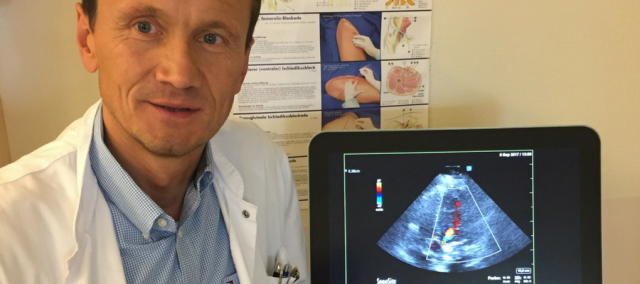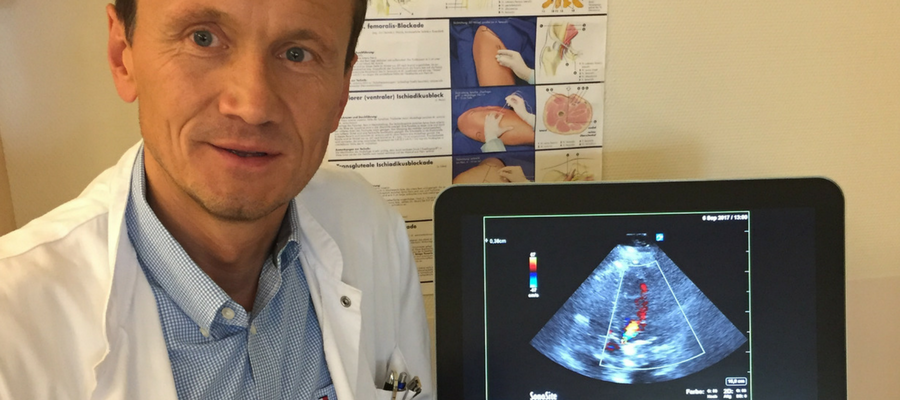
With constant pressure on healthcare providers to improve the quality and efficiency of care while reducing costs, standardization of patient management is a logical step towards more streamlined services. Anesthesia is one area that is beginning to embrace this approach, combining regional nerve blocks with ultrasound guidance to improve both the quality and effectiveness of patient care while minimizing hospital stays.
Dr. Martin Zoremba (PhD), Chief Registrar in the anesthesia Department at Kreisklinikum Siegen, describes the transformation of his department and the benefits that a standardized approach offers.
Outpatient surgery is a good example of how healthcare practices are changing to deliver cost savings while improving patient care and satisfaction. Widely regarded as a more efficient way of carrying out many minor operations, this approach relies on using regional nerve blocks as an alternative to general anesthesia. This helps to shorten recovery times – often allowing patients to return home the same day – and avoids the potential complications associated with general anesthesia, as well as providing better post-operative pain control.
Regional blocks can also improve safety and simplify management for high risk patients, making the technique especially useful for time critical interventions in trauma patients.
Despite these advantages, many hospitals across Europe are yet to fully embrace regional anesthesia. There are a variety of reasons for this, including a lack of funding for the point-of-care (POC) ultrasound systems necessary to quickly and effectively carry out regional blocks, a poor understanding of the workflow benefits, and a resistance to changing established practices, from both within and outside the anesthesia department.
Dr. Martin Zoremba is a leading proponent of this approach, having earned a PhD in regional anesthesia and perioperative hemodynamics using ultrasound at the University Hospital of Giessen and Marburg. Since moving to Kreisklinikum Siegen in 2015, he has completely overhauled the way the department runs, introducing POC ultrasound for regional anesthesia and standardizing practices for many of the departments protocols.
“When I arrived in the department,” says Dr. Zoremba, “there was very little regional anesthesia being performed, and no use of POC ultrasound. Based on my experiences in Marburg, I knew the benefits that this approach could bring to both patient care and the department’s workflow, and immediately began training the anesthesia team here to perform ultrasound-guided regional blocks. We also created SOPs for many of our activities within the department, including how and when ultrasound should be used.”
Within a year, the department had switched to regional anesthesia for a large proportion of procedures. This dramatic change in how the department operates initially met with some resistance, but the benefits quickly became clear.
“SOPs make it very clear for everyone what the correct protocol is, simplify decision making, and help to improve the flow of patients, explained Dr. Zoremba. “This ensures a consistently high level of care and allows the department to run efficiently while still meeting the individual needs of each patient. Successfully converting to this type of approach requires both staff and management buy-in and, just as importantly, clear goals from the outset.
“For example, within our department, the economic argument for switching to ultrasound-guided regional anesthesia and pain control was very clear. Every day a patient spends in hospital costs approximately €500 so, even if we only shorten each patient’s stay by one day, that saves over €1 million for the 3-4,000 orthopedic and trauma patients we treat each year. Equally importantly, the changes we have implemented have led to improved patient satisfaction and a much smoother flow of patients, so staff can clearly see the advantages.”
Dr. Zoremba attributes this rapid turnaround to an intensive training program and the ease of use of the department’s POC ultrasound systems like the Sonosite X-Porte.
“We use a ‘landmark’ based anatomical approach, making it easy for even novice ultrasound users to quickly learn to locate the nerves and guide the needle to the injection site. We combine this with an in-plane technique using a Sonosite X-Porte’s excellent linear transducer, as this offers very good needle visualization, even for inexperienced users.
“We can perform over 99% of all blocks this way – even very deep blocks and sciatic blocks – which is both fast and efficient, and avoids the use of nerve stimulators, improving patient comfort. Each anesthetist in the department has been trained in this way, and newly qualified junior doctors coming through the department undertake a 3-week POC ultrasound boot camp with 1-on-1 training in ultrasound-guided blocks with a senior physician.
“Our X-Porte systems are ideal teaching tools, and represent one of the most complete devices on the market for anesthesia. The touchscreen interface is also very good, making it easy to optimize images, and being very easy to clean. Just as importantly, the versatility of the ultrasound system allows us to perform other types of ultrasound scan – particularly transthoracic echocardiography (TEE) for the hemodynamic management of trauma patients.
“Perioperative TEE evaluation using the X-Porte can be easily implemented, allowing optimized, patient-specific risk management and treatment. This avoids overloading the patient with anesthetic, shortening recovery times and hospital stays, which also helps to reduce pressure on post-operative intensive care resources. It’s good for both the patient and the hospital.
“Changing even small elements of workflows can benefit a whole department, and many anesthesia department leaders will likely have had similar ideas. Unfortunately, resistance to changing long-established individual practices can be a significant challenge; many good ideas have never been implemented due to a lack of resources or support, either internal or external.”
To help address this, Dr. Zoremba’s team has recently developed a new anesthesia workshop – “to our knowledge, the only one of its kind in Europe,” says Dr. Zoremba – which focuses on implementing POC ultrasound skills.
“Combining theoretical and hands-on ultrasound training with sessions on change management,” says Dr. Zoremba, “will hopefully enable more anesthesia departments to benefit from the use of regional anesthesia.”
Learn More About the Sonosite X-Porte
Anesthesiologists who utilize ultrasound guidance for needle placement see a decrease in vascular puncture and an increase in the effectiveness of pain management medication, Intuitive Touchscreen Interface, and the Sonosite X-Porte's intuitive touchscreen interface allows anesthesiologists to easily customize the user interface to suit their needs.



